ANGLES AND PARALLEL LINES WORKSHEET
Subscribe to our ▶️ YouTube channel 🔴 for the latest videos, updates, and tips.
1. In the figure shown below, m∠2 = 75°. Find the measures of the remaining angles.
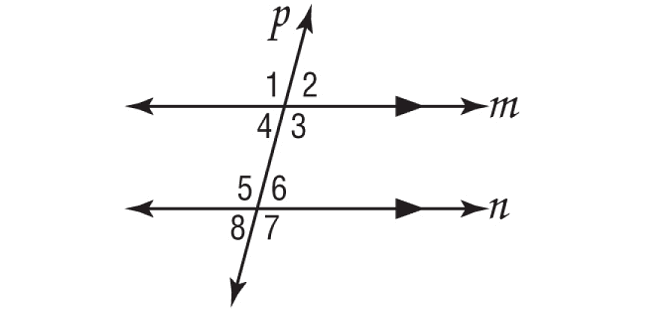
2. In the figure shown below, m∠3 = 102°. Find the measure of each angle. Tell which postulate(s) or theorem(s) you used.
a. ∠5 b. ∠6 c. ∠11 d. ∠7 e. ∠15 f. ∠14
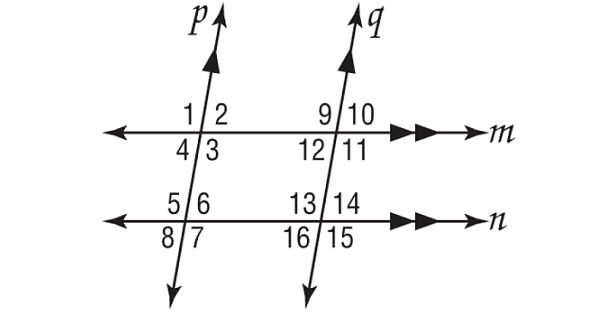
3. In the figure shown below, m∠2 = 92° and m∠12 = 74°. Find the measure of each angle. Tell which postulate(s) or theorem(s) you used.
a. ∠10 b. ∠8 c. ∠9 d. ∠5 e. ∠11 f. ∠13
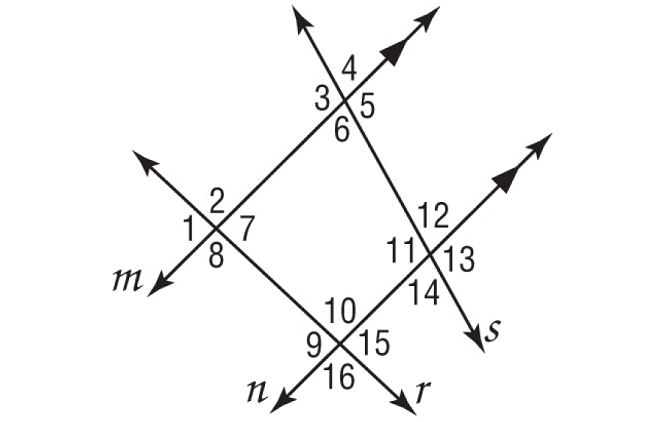
4. If m∠1 = 3x + 15, m∠2 = 4x - 5, and m∠3 = 5y, find the values of x and y.
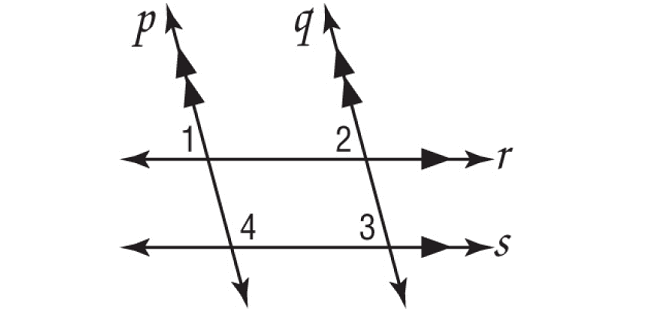
5. In the figure shown below, find the values of x and y.

6. In the figure shown below, find the values of x, y and z.

7. In the figure shown below, find the values of x and y.
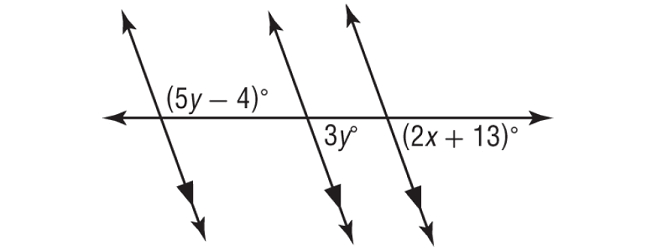
8. Using a 3rd parallel Line – Auxiliary Line, find the value of x.
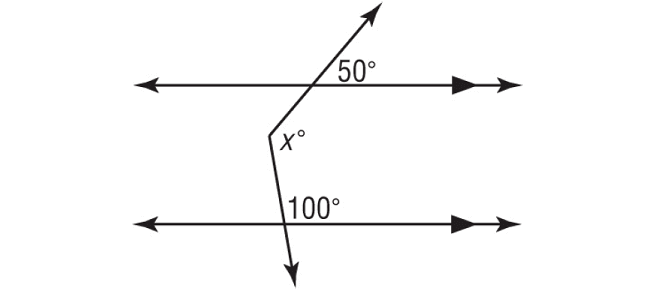
9. Using a 3rd parallel Line – Auxiliary Line, find the value of x.
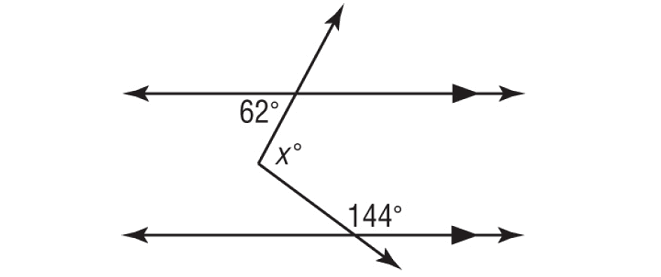
10. A diagonal brace strengthens the wire fence and prevents it from sagging. The brace makes a 50° angle with the wire as shown. Find the value of the variable.
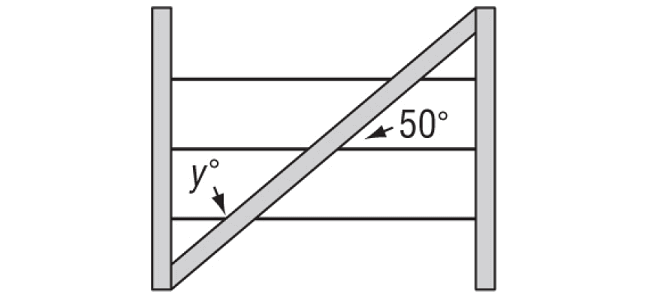

Answers
1. Answer :
∠1 and ∠2 form a linear pair and they are supplementary.
m∠1 + m∠2 = 180°
m∠1 + 75° = 180°
m∠1 = 105°
∠1 and ∠3 are vertically opposite angles and they are equal.
m∠3 = m∠1
m∠3 = 105°
∠2 and ∠4 are vertically opposite angles and they are equal.
m∠4 = m∠2
m∠4 = 75°
∠1 and ∠5 are corresponding angles and they are equal.
m∠5 = m∠1
m∠5 = 105°
∠2 and ∠6 are corresponding angles and they are equal.
m∠6 = m∠2
m∠6 = 75°
∠4 and ∠8 are corresponding angles and they are equal.
m∠8 = m∠4
m∠8 = 75°
∠3 and ∠7 are corresponding angles and they are equal.
m∠7 = m∠3
m∠7 = 105°
2. Answer :
(a) :
m∠5 = m∠3
m∠5 = 102°
(Alternate Interior Angles Theorem)
(b) :
m∠3 + m∠6 = 180°
102° + m∠6 = 180°
m∠6 = 78°
(Interior Angles on the Same Side of the Transversal Theorem)
(c) :
m∠11 = m∠3
m∠11 = 102°
(Corresponding Angles Postulate)
(d) :
m∠7 = m∠3
m∠7 = 102°
(Corresponding Angles Postulate)
(e) :
m∠15 = m∠7
m∠15 = 102°
(Corresponding Angles Postulate)
(f) :
m∠14 = m∠6
m∠14 = 78°
(Corresponding Angles Postulate)
3. Answer :
(a) :
m∠10 = m∠2
m∠10 = 92°
(Corresponding Angles Postulate)
(b) :
m∠8 = m∠2
m∠8 = 92°
(Vertical Angles Theorem)
(c) :
m∠9 + m∠10 = 180°
m∠9 + 92° = 180°
m∠9 = 88°
(Linear Pair Postulate)
(d) :
m∠5 + m∠12 = 180°
m∠5 + 74° = 180°
m∠5 = 106°
(Interior Angles on the Same Side of the Transversal Theorem)
(e) :
m∠11 = m∠5
m∠11 = 106°
(Alternate Interior Angles Theorem)
(f) :
m∠13 = m∠11
m∠13 = 106°
(Vertical Angles Theorem)
4. Answer :
∠1 and ∠2 are corresponding angles and they are equal.
m∠1 = m∠2
3x + 15 = 4x - 5
Subtract 3x from each side.
15 = x - 5
Add 5 to each side.
20 = x
∠2 and ∠3 are corresponding angles and they are equal.
m∠2 = m∠3
4x - 5 = 5y
Substitute x = 20.
4(20) - 5 = 5y
80 - 5 = 5y
75 = 5y
Divide each side by 5.
15 = y
Therefore,
x = 20 and y = 15
5. Answer :
(3y + 18)° and 90° are interior angles on the same side of the transversal and they are supplementary.
(3y + 18)° + 90° = 180°
3y + 18 + 90 = 180
3y + 108 = 180
Subtract 108 from each side.
3y = 72
Divide each side by 3.
y = 24
10x° and (15x + 30)° are interior angles on the same side of the transversal and they are supplementary.
10x° + (15x + 30)° = 180°
10x + 15x + 30 = 180
25x + 30 = 180
Subtract 180 from each side.
25x = 150
Divide each side by 25.
x = 6
Therefore,
x = 6 and y = 24
6. Answer :
2x°, 90° and x° together form a straight angle.
2x° + 90° + x° = 180°
3x + 90 = 180
Subtract 90 from each side.
3x = 90
Divide each side by 3.
x = 30
x° and 2y° are alternate interior angles and they are equal.
2y° = x°
2y = x
Substitute x = 30.
2y = 30
Divide each side by 2.
y = 15
2y° and z° form a linear pair, they are supplementary.
2y° + z° = 180°
2y + z = 180
Substitute y = 15.
2(15) + z = 180
30 + z = 180
Subtract 30 from each side.
z = 150
Therefore,
x = 30, y = 15 and z = 150
7. Answer :
Mark a new angle a°.
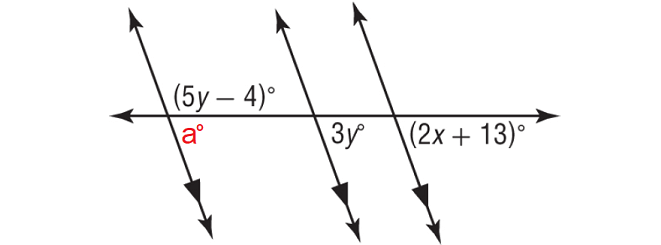
a° and (5y - 4)° form a linear pair.
a° + (5y - 4)° = 180°
a° and 3y° are corresponding angles, then a° = 3y°.
3y° + (5y - 4)° = 180°
3y + 5y - 4 = 180
8y - 4 = 180
Add 4 to each side.
8y = 184
Divide each side by 8.
y = 23
3y° and (2x + 13)° are corresponding angles and they are equal.
(2x + 13)° = 3y°
2x + 13 = 3y
Substitute y = 23.
2x + 13 = 3(23)
2x + 13 = 69
Subtract 13 from each side.
2x = 56
Divide each side by 2.
x = 28
8. Answer :
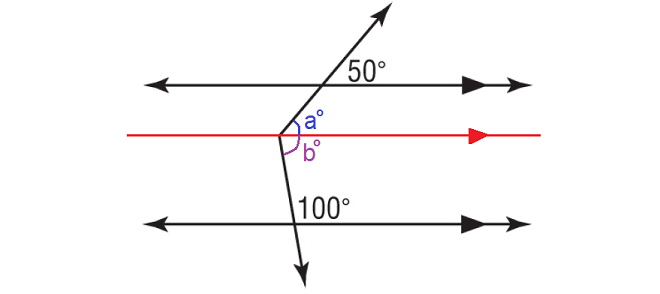
In the figure above, a° and 50° are corresponding angles and they are equal.
a° = 50°
b° and 100° are interior angles on the same side of the transversal and they are supplementary.
b° + 100° = 180°
Subtract 100° from each side.
b° = 80°
In the above figure,
x = a + b
= 50 + 80
= 130
9. Answer :
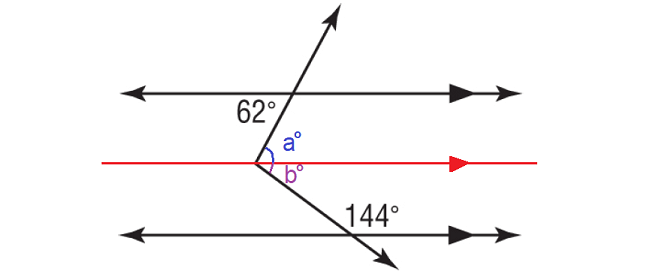
In the figure above, a° and 62° are alternate interior angles and they are equal.
a° = 62°
b° and 144° are interior angles on the same side of the transversal and they are supplementary.
b° + 144° = 180°
Subtract 144° from each side.
b° = 36°
In the above figure,
x = a + b
= 62 + 36
= 98
10. Answer :
Mark a new angle x°.
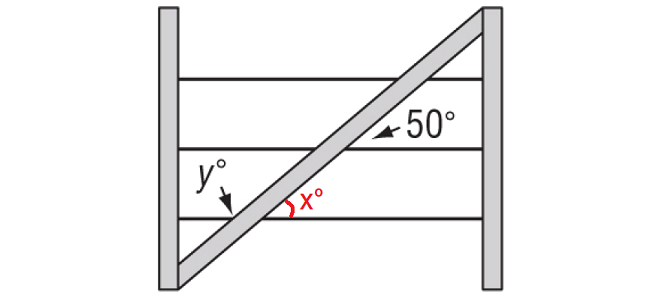
x° and y° form a linear pair.
x° + y° = 180°
x° and 50° are corresponding angles, then x° = 50°.
50° + y° = 180°
50 + y = 180
Subtract 50 from each side.
y = 130
Subscribe to our ▶️ YouTube channel 🔴 for the latest videos, updates, and tips.
Kindly mail your feedback to v4formath@gmail.com
We always appreciate your feedback.
About Us | Contact Us | Privacy Policy
©All rights reserved. onlinemath4all.com

Recent Articles
-
US Common Core K-12 Curricum Algebra Solving Simple Equations
Jan 07, 26 01:53 PM
US Common Core K-12 Curricum Algebra Solving Simple Equations -
10 Hard SAT Math Questions (Part - 4)
Jan 05, 26 06:56 PM
10 Hard SAT Math Questions (Part - 4) -
10 Hard SAT Math Questions (Part - 3)
Jan 05, 26 06:34 PM
10 Hard SAT Math Questions (Part - 3)

